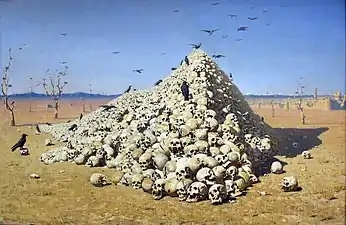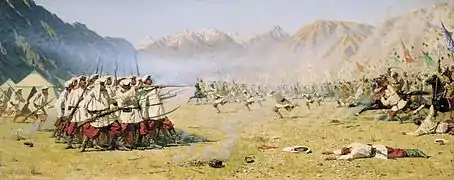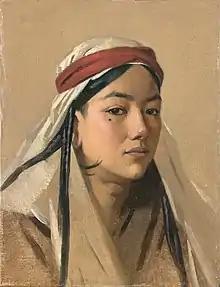Vereshchagin's Turkestan Series is a collection of 13 paintings produced by Russian artist Vasily Vereshchagin in the 19th-century. While initially purchased en masse by a Russian collector, the works have since been added to the collections of the Tretyakov Gallery in Moscow and the Russian Museum in Saint Petersburg.[1]
History
In the 1867, Russian artist Vasily Vereshchagin (who had recently finished studying painting in Paris) was informed that the Governor of Russian Turkestan, Konstantin von Kaufmann, required cartographers and painters for military service in Imperial Russia's Central Asian territories.[2] Enticed by the freedom such a position would provide,[2] Vereshchagin enlisted and was deployed to Samarkand in Turkestan, where a war had recently broken out between Russia and the Emirate of Bukhara.
In the several years of intermittent fighting that followed, Vereshchagin was attached to the Russian army; he painted, and on occasion fought against the various nations that opposed Russian expansion into Central Asia. Per his role as a war artist, many of Vereshchagin's works depict battle scenes; however, the artist also produced (both during his military service and during a second trip after his service had ended) a number of ethnographic and landscape paintings depicting the scenery of Central Asia. Many of these paintings, though classified as orientalist,[2][1] were realistic and relatively uncensored, a fact that was in stark contrast to the works of Vereshchagin's Russian contemporaries.[3] As noted by one source, Vereshchagin's work exudes feelings of decline and decay;[2] many scenes he painted feature death, and the artist often painted the ruins of once-great civilizations that had since gone into decline.[2] As Vereshchagin himself noted, "My main purpose [was]…to describe the barbarism with which until now the entire way of life and order of Central Asia has been saturated."[2]
Following his second trip to Turkestan in 1869, Vereshchagin (who was residing in Munich) began producing a series of paintings that would become known as his "Turkestan Series". These 13 works of art were painted between 1869 and 1872; some were imaginary pieces, but most were renderings of scenes that Vereshchagin had observed while in Turkestan.[2]
Upon the completion of his works, Vereshchagin chose to present his collection of paintings at the Crystal Palace in London, as Russia was at the time considered an artistic backwater.[2] In Britain, his work was well-received.[2] Upon his return to Russia, Vereshchagin's paintings were likewise well-received by the general public.[2] However, his depiction of the brutal nature of the war and of the Russian war dead displeased some members of the Russian military, who saw the depiction of dead Russian soldiers as being defeatist and unpatriotic.[2] Two of his works in particular, The Apotheosis of War and Left Behind, were singled out for criticism.[4] Regardless, Vereshchagin was able to sell many of his paintings to a private buyer, Sergei Tretyakov. Upon Tretyakov's death in 1892, his collection of art, including the Turkestan Series, was donated to city of Moscow. From there, the paintings of the series were split between the Tretyakov Gallery in Moscow and the Russian Museum in Saint Petersburg.[1][2]
Gallery
- Assortment of paintings making up Vereshchagin's Turkestan Series
 The Apotheosis of War, 1872, oil on canvas
The Apotheosis of War, 1872, oil on canvas They Attack Unaware, 1871, oil on canvas
They Attack Unaware, 1871, oil on canvas In the Alatau Mountains, circa 1870, oil on canvas
In the Alatau Mountains, circa 1870, oil on canvas Portrait of bacha
Portrait of bacha
References
- 1 2 3 "musings-on-art.org". musings-on-art.org. 2015-02-25. Retrieved 2018-11-17.
- 1 2 3 4 5 6 7 8 9 10 11 12 David, Schimmelpenninck van der Oye (2009-12-01). "Vasilij V. Vereshchagin's Canvases of Central Asian Conquest". Cahiers d'Asie centrale (17/18): 179–209. ISSN 1270-9247.
- ↑ "Туркестанская серия. Художник Василий Верещагин. Живопись, графика, фото. Туркестан. Картины о войне". veresh.ru. Retrieved 2018-11-17.
- ↑ Chisholm, Hugh, ed. (1911). . Encyclopædia Britannica. Vol. 27 (11th ed.). Cambridge University Press. p. 1021.